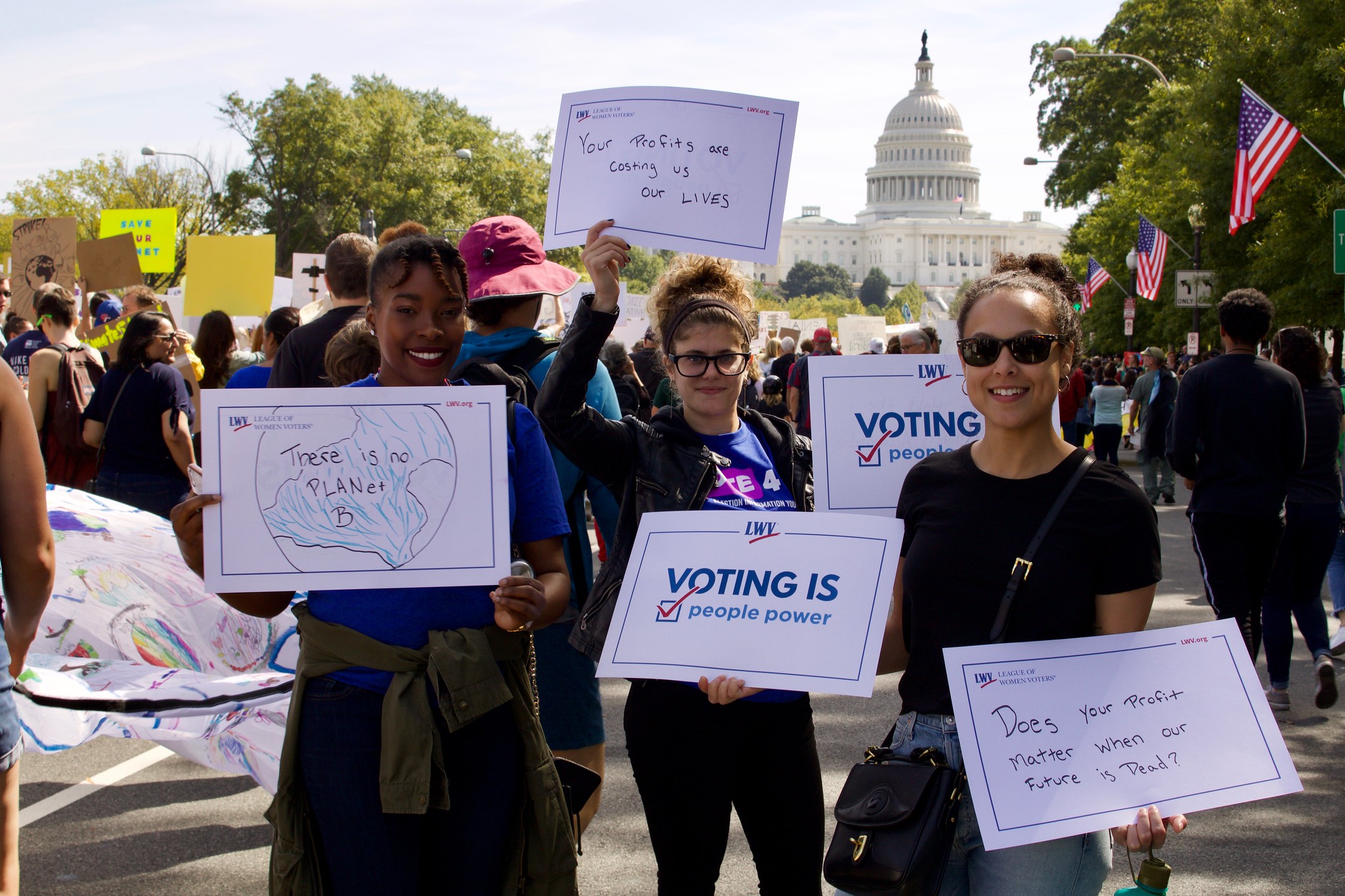What I Learned at the UN Climate Change Conference
Written by League member Emily Polakowski
During the first two weeks in November, the United Kingdom hosted the UN Climate Change Conference (COP26) in Glasgow, Scotland. I was the lucky recipient of a scholarship to attend this event as a delegate observer for the League of Women Voters of the United States.
I’ll be the first to admit that my knowledge of loss and damage vs. adaptation vs. mitigation, feminist climate justice, and the carbon market were limited. I knew that climate change was real and needed to be slowed, but I didn’t know all the intricacies or the depth of experiences that were currently happening around the world. But by the end of my week in Glasgow, I had learned so much and become energized around this topic! Now, I have to-do lists for local and individual actions, local and national groups to join, and lists of library books to read in an effort to do my part to “keep 1.5 alive”(see below).
The Severity of Climate Change
The Intergovernmental Panel on Climate Change (IPCC) released their most recent report in August 2021: “AR6 Climate Change 2021: The Physical Science Basis.” This report was written by the world’s leading climate scientists and can be viewed in its entirety on their website along with an interactive atlas and regional fact sheets.
This report states that recent climate changes are “widespread, rapid, intensifying, and unprecedented in thousands of years” and are indisputably attributed to human activities. “Unless there are immediate, rapid, and large-scale reductions in greenhouse gas emissions, limiting warming to 1.5 and even 2 [degrees Celsius] will be beyond reach” (hence “keep 1.5 alive”).
AT COP26, I was also able to watch Al Gore’s live presentation, “The Danger We’re In and the Case for Hope,” which featured hundreds of photographs and video clips from current weather events that are attributed to climate change. I was aware that some of these droughts, floods, and fires were likely impacted by climate change, but the impact of seeing photograph after photograph after photograph was staggering.
Even the hot temperatures in the Pacific Northwest this summer would have been labeled “statistically impossible” in the past, but these events are becoming more and more common. Events called Atmospheric rivers result in rain bombs, mud slides, and the flooding of homes and transportation systems. Permafrost melting in Siberia results in greenhouse gas and methane emissions. The UN predicts that there will be up to 1 billion climate refugees by the end of the century because their current homes will become incompatible with human life.
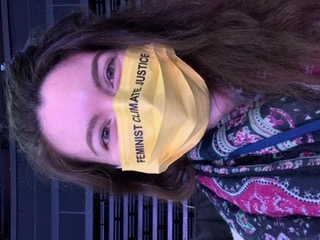
The author wearing a "feminist climate justice" mask
This disconnect between countries in the Global South and Global North was evident at COP26. Countries in the Global South are facing devastating impacts from climate change that threaten their economy, livelihood, and mortality. Island countries, such as Fiji and Tuvalu, spoke out about the impact of sea level rises that are removing their land. Madagascar is facing the first climate-driven famine, impacting more than one million citizens due to drought and coral bleaching.
These countries are seeking monetary support for “loss and damage” as they are facing impacts today from changes to the climate that have occurred because of the Global North’s carbon emissions. Loss and damage remained a controversial subject throughout COP. In the closing agreement, the costs of loss and damage were acknowledged, but there has been no established fund to provide assistance to these countries yet. There are talks for an official financial mechanism for loss and damage compensation to be introduced at next year’s event, COP 27.
Feminism and Climate Justice
Each day, the Women and Gender Constituency, of which LWVUS is a member, passed out masks that said ‘Feminist Climate Justice.’ I was unfamiliar with this concept prior to my attendance, but have since learned about the intersectionality of these movements.
Women are often more impacted by climate change than men, as they are responsible for the majority of food preparation, child care, and care of the home, and are therefore more vulnerable to infrastructure disasters. It’s estimated that as many as 80% of climate change refugees are female.
Women are also less likely to receive messaging about climate emergencies and be able to physically escape from danger from a climate event. As a result, more than 70% of the fatalities in the 2004 tsunami were women.
The climate justice movement is intersectional in many respects. Notably, both people living in poverty, as well as communities of color, are most affected by climate change impacts and have fewer resources to face unpredictable events. Desmond Tutu has stated, “climate change is the human rights challenge of our times”, and ”the most devastating effects are visited on the poor, those with no involvement in creating the problem”.
Deforestation
Deforestation was a hot topic in the first week of COP, as more than 100 countries promised to end and reverse deforestation by the year 2030. Over $19 billion was pledged; however, there is a history of countries pledging money at international conferences with limited follow-through, limiting the impact of these statements.
I attended a talk in the United States Pavilion about the LEAF Coalition, which is a combined public and private partnership to stop deforestation. Private companies (Walmart, Amazon, AirBnB, etc) are supporting countries (Ghana, Nepal, Ecuador, Vietnam, Costa Rica) in their commitments to limit deforestation by providing financial incentives and support. Ecuador’s representative said, “we have the new currency the world needs: biodiversity.”
These developing countries make the commitments to preserve nature and then receive financial benefits from the companies in exchange for carbon credits. In this way, these companies can appear “net zero” by simply purchasing the carbon credits. Yet some of these ideas could appear to be ‘greenwashing’ — where companies try to appear more environmentally friendly rather than make actual sustainable changes to their organization.
Takeaways
At the end of the conference, an official agreement, “The Glasgow Climate Pact,” was reached by all members of the conference. However, even if all of those commitments are followed, the Earth’s temperature would still raise 2.4 degrees C above pre-industrial levels, far above the goal of 1.5 degrees. Additionally, there is no established way to enforce these commitments or to ensure that they will be followed.
I have learned so much about climate change, climate policies, and climate justice since attending COP26, but my biggest take-away is the division between the people on the ground that are facing these impacts every day and identifying solutions as their lives and livelihoods depend on it, and the people making the decisions. Women, indigenous people, young people, and people in the Global South have a lot to say on this topic, and they’re often not invited into the rooms where the decisions are made. COP talked up its “inclusivity” and record number of attendees, but many negotiations and events were severely restricted. Many people were allowed into the conference grounds, but were not allowed in the actual rooms where these discussions occurred.
Although the largest impacts to limit climate change will come from countries and corporations, individuals can make a difference as well, especially by applying pressure and sharing their thoughts with elected officials. What can we do today to make a difference?
-
Vote! Vote for individuals at both the local and national level that are working towards climate change initiatives, legislation, and carbon neutrality.
-
Amplify your voice by joining local climate groups. There are so many groups out there. Look for one that fits your areas of interest, whether that’s water conservation, native plants, carbon taxes, installing charging stations for electric vehicles, etc.
-
Ensure that your electricity comes from a renewable source. Most utility companies offer ‘green energy’ to limit your reliance on fossil fuels — you just have to ask and maybe pay a small premium.
-
Consider purchasing an electric vehicle when you’re in need of new transportation, or use public transportation when available. More and more companies plan to release electric cars and plug-in hybrid vehicles over the next five years.
-
Eat less meat, especially beef, and cheese. Due to their stomach design, cows are huge producers of methane, whose warming potential is estimated at 20-28 times higher than CO2. Cow farms also lead to land loss and deforestation, as they require more acreage of land than crops.
-
Be a thoughtful consumer. The fashion industry contributes to a substantial chunk of greenhouse gas emissions from human activity — about 10% by some estimates. Buy used clothing and look at the practices of the companies you purchase from. Limiting your Amazon delivery day to once per week can also help limit greenhouse gas emissions.
The Latest from the League
People often refer to climate change as an “existential threat.” This makes sense; our existence is being threatened. But as a health professional, I’d like to move away from the big, existential side of things and focus on the everyday public and individual human health threats that climate change is already causing and that most certainly will continue to worsen.
LWVUS joined partners on a letter to Congressional leadership that urges them to address the climate crisis in the budget legislation.
LWVUS endorsed the reintroduction of the Climate Risk Disclosure Act of 2021.
Sign Up For Email
Keep up with the League. Receive emails to your inbox!
Donate to support our work
to empower voters and defend democracy.

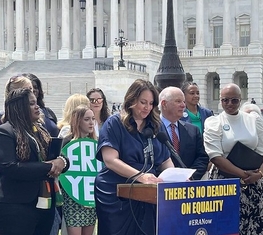
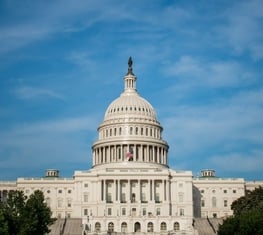
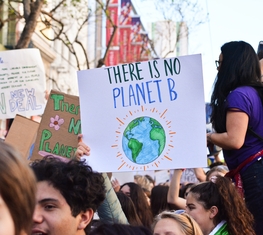
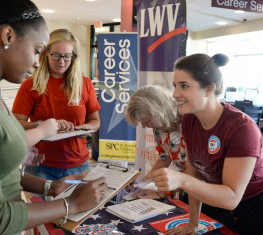

_4.png?itok=PURqK3EE)
